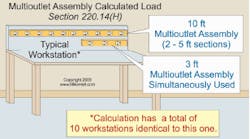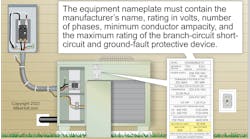Last month in Code Basics, “Commercial Loads — Part 1,” on page 24 of the January issue, we discussed when it’s okay to apply demand factors when calculating electrical load requirements for commercial installations. Because different sets of demand factors apply for different types of electrical loads (and even for different types of commercial buildings), this article demonstrated why it’s important to determine what kinds of loads you have before starting your commercial load calculations.
In part two of this installment, it’s time to address how to calculate receptacle loads and introduce the optional calculation method for commercial occupancies.
The basics
The multioutlet receptacle assembly, such as a plug strip, is common in commercial applications. For each 5 ft (or fraction thereof) of multioutlet receptacle assembly, use 180VA in your feeder/service calculations. This is assuming that it's unlikely for the appliances plugged into this assembly to operate simultaneously [220.14(H)].
If you expect several appliances to operate simultaneously from the same multioutlet receptacle assembly, consider each foot (or fraction of a foot) as 180VA for feeder/service calculations. A multioutlet receptacle assembly isn't generally considered a continuous load.
Try this sample problem to determine the feeder/service load. What's the calculated load for 10 workstations (Fig. 1), each of which has 10 ft of multioutlet receptacle assembly (not used simultaneously) and 3 ft of multioutlet receptacle assembly (used simultaneously)?
10 stations with 10 ft per station = 100 ft of multioutlet assembly (not simultaneously used)
10 stations with 3 ft per station = 30 ft of multioutlet assembly (simultaneously used)
100 ft ÷ 5 ft per section = 20 sections x 180VA = 3,600VA
30 ft ÷ 1 ft per section = 30 sections x 180VA = 5,400VA
Calculated load = 3,600VA + 5,400VA = 9,000VA
This next example shows how to size the branch circuits using 20A branch circuits.
First, find the VA allowed per circuit:
120V x 20A = 2,400VA for noncontinuous loads
Then, divide by 180VA to find how many 180VA sections a 20A circuit can serve:
2,400VA ÷ 180VA = 13
Each work bench requires 2 – 180VA sections for the 10 ft section, and 3 – 180VA sections for the 3 ft section, which is 5 – 180VA sections per workbench. At 13 sections per circuit, a 20A branch circuit can serve two tables.
Receptacle VA load
Receptacles are generally not considered continuous loads. The load for a general-use receptacle outlet in a non-dwelling occupancy is 180VA per strap [220.14(I)]. The maximum number of receptacle outlets permitted on a commercial or industrial circuit depends on the circuit ampacity. Calculate the number of receptacles per circuit by dividing the VA rating of the circuit by 180VA for each receptacle strap (also called a yoke), as shown in Fig. 2.
Based on the Art. 100 definition, a duplex receptacle is two receptacles on the same yoke. For the purposes of this calculation, a single receptacle or a duplex receptacle each count as 180VA [220.14(I)].
Receptacle feeder/service calculated load
Calculate receptacle loads at not less than 180VA per outlet (strap) per 220.14(I) and fixed multioutlet assemblies per 220.14(H). According to 220.44, you can add these calculated loads to the lighting loads and apply the lighting load demand factors given in Table 220.42. Alternatively, you can use the demand factors for receptacles given in Table 220.44, which are as follows:
- First 10kVA at 100% demand factor.
- Remainder over 10kVA at 50% demand factor.
Calculate the receptacle load using 180VA for each single or multiple receptacle on one yoke or strap [220.14(I)].
The receptacle calculated load for office buildings and banks is the larger calculation of (1) or (2):
- Determine the receptacle calculated load at 180VA per receptacle yoke [220.14(I)], then apply the demand factor from Table 220.44.
- Determine the receptacle calculated load at 1VA per sq ft.
It's common not to know the exact number of receptacles that will eventually be installed in an office building or bank. The main structure is built first, then individual office space that's rented out to each tenant will often have a custom installation — or a new tenant will remodel the space to fit his or her needs. A calculation of 1VA per square foot allows a generic feeder/service demand for general receptacles.
What is the receptacle calculated load for an 18,000-sq-ft bank/office building containing 160 15A and 20A, 125V receptacles (straps)? [220.14(K)(1)], as shown in Fig. 3.
160 receptacles (straps) x 180VA [220.14(I)] = 28,800VA
Total receptacle load = 28,800VA
First 10,000VA at 100% (10,000VA x 1.00 = 10,000VA)
Remainder at 50% (18,800VA x 0.50 = 9,400VA) [Table 220.44]
Receptacle calculated load = 19,400VA
Compare this to the 1VA per sq ft method [220.14(K)(2)]
18,000 x 1VA per sq ft = 18,000VA (smaller answer, omit)
Sign circuits
The NEC requires each commercial occupancy accessible to pedestrians to have at least one 20A branch circuit for a sign [600.5(A)]. The load for the required exterior sign or outline lighting must be a minimum of 1,200VA [220.14(F)]. A sign outlet is a continuous load, and the feeder/service conductor must be sized at 125% of the continuous load [215.2(A)(1) and 230.42].
What is the feeder/service conductor calculated load for one electric sign (Fig. 4)?
Feeder/service calculated load = 1,200VA x 1.25 = 1,500VA
Commercial/industrial vs. residential
You've probably noticed that receptacle calculations for commercial/industrial applications differ from those that apply to residential applications. The differences exist because in residential locations, the receptacles are generally placed much closer together for convenience purposes but used in a diverse manner — so that all receptacles are not heavily loaded during all periods of time. In commercial occupancies, there are fewer rules governing receptacle placement, so they may be placed as needed, but may be called into use more often and for longer periods of time. In dwelling units, the receptacle load is included in the general lighting load VA calculated according to Table 220.12 and is then subject to the demand factors of Table 220.42. The 180VA per receptacle strap allowance does not apply to dwelling unit calculations.
In Part 1, we looked at how to calculate commercial loads using the standard method. You can save time by using the optional method. The optional method calculations are located in Part IV of Art. 220. The optional method calculations vary according to the type of building:
- New dwelling units (220.82)
- Existing dwelling units (220.83)
- Multifamily dwellings (220.84)
- Schools (220.86)
- New restaurants (220.88)
All-electric restaurant
If a restaurant has electric space heating, electric air-conditioning, or both, you can use the optional method, which consists of the following two steps:
- Determine the total connected load. Add the nameplate rating of all loads at 100%, including both the air-conditioning and heating load [Table 220.88 Note].
- Apply the demand factors from Table 220.88 to the total connected load calculated in Step 1.
An example will help illustrate how the optional method works for restaurants. What's the calculated load for an all-electric restaurant (120/208V, 3-phase) that has a total connected load of 300kVA?
Total connected load = 300kVA
First 200kVA at 80% (200kVA x 0.80 = 160kVA)
Next 201kVA to 325kVA at 10% (100kVA x 0.10 = 10kVA
Total calculated load = 170kVA
I = VA ÷ (E x 1.732)
I = 170,000VA ÷ (208V x 1.732)
I = 170,000VA ÷ 360V = 472A
Paralleling two conductors per phase: 472A ÷ 2 raceways = 236A
250kcmil is rated 255A at 75ºC: 255A x 2 conductors (in parallel) = 510A
The minimum neutral size allowed when paralleling conductors is 1/0 AWG [250.24(C)(2) and 310.4].
What size grounding electrode conductor do you need if the service uses two sets of 250kcmil conductors in parallel?
First, find the equivalent area of the parallel conductors:
250kcmil x 2 conductors = 500kcmil [Table 250.66, Note 1]
500kcmil requires a 1/0 AWG grounding electrode conductor [Table 250.66].
The largest grounding electrode conductor to a ground rod is 6 AWG. The largest to a concrete encased electrode (Ufer) is 4 AWG [250.66(A) and 250.66(B)].
Not all-electric restaurant
What if the restaurant isn't all-electric? Try calculating the load for a not all-electric restaurant (120/208V, 3-phase) that has a total connected load of 300kVA.
Total connected load = 300kVA
First 200kVA at 100% (200kVA x 1.00 = 200kVA
201kVA to 325kVA at 50% (100kVA x 0.50 = 50kVA
Total calculated load = 250kVA
I = VA ÷ (E x 1.732)
I = 250,000VA ÷ (208V x 1.732)
I = 250,000VA ÷ 360V = 694A
Paralleling two conductors per phase: 694A ÷ 2 raceways = 347A
500kcmil is rated 380A at 75°C: (380A x 2 = 760A).
When a calculation result does not correspond to a standard overcurrent protection size, we are allowed to round up to the next standard size, as long as it does not exceed 800A [240.4(B)]. This would allow the use of an 800A overcurrent device [240.6(A)]
The minimum neutral size when paralleling conductors is 1/0 AWG [250.24(C)(2) and 310.4].
Fortunately, you don't have to use both the standard and optional methods and then pick the one that is the larger. You are allowed to use either approach, so you can save time by using the optional method.




